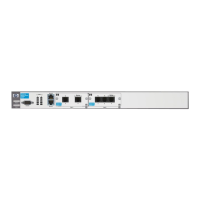11-24
IP Routing—Configuring Static Routes
Troubleshooting Static Routing
Troubleshooting Static Routing
When you receive reports that traffic is not reaching its destination, first
attempt to ping the destination from the router to verify that a host or other
network node is not the root of the problem. If the ping confirms that the router
cannot reach the destination, next view the routing table.
Note The show and debug commands described in the following sections are
enable mode commands. You can also enter the commands from configuration
mode contexts by adding the do option.
Monitoring the Routing Table
To view the routing table, enter this enable mode command:
Syntax: show ip route
The screen displays the destinations to which the router can route traffic. (See
Figure 11-8.) For each destination, the routing table also records:
■ the method the router used to discover the route
•B—BGP
• C—directly connected
• O—OSPF
•R—RIP
• S—entered manually (static)
■ the administrative distance—the trustworthiness of the route, used to
choose between two identical routes discovered through different
methods
■ the metric—the cost for the route
■ the next-hop address
■ the forwarding interface

